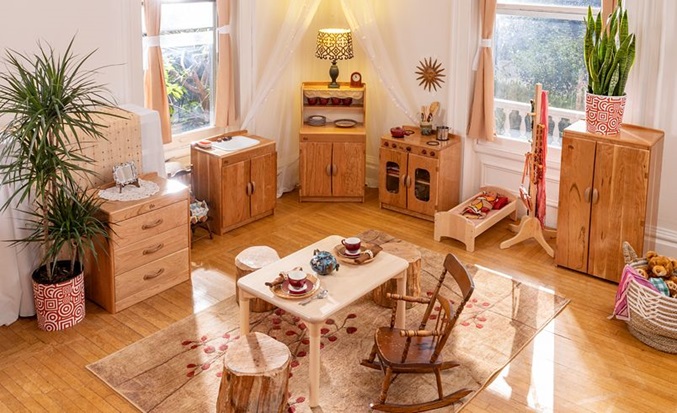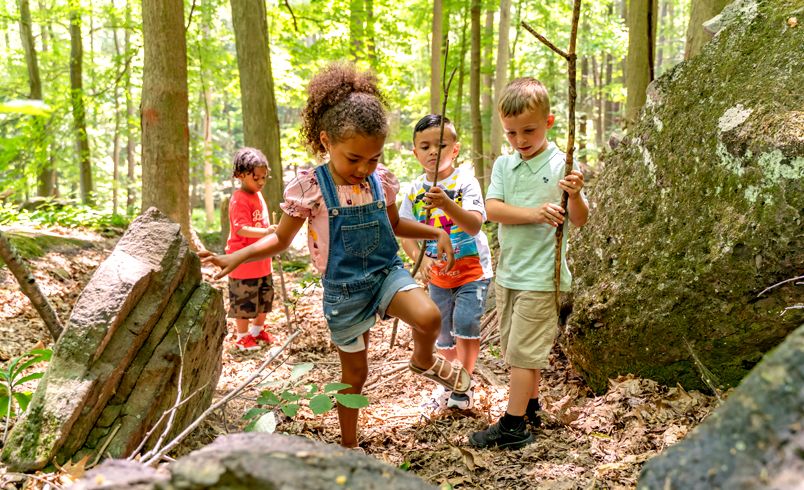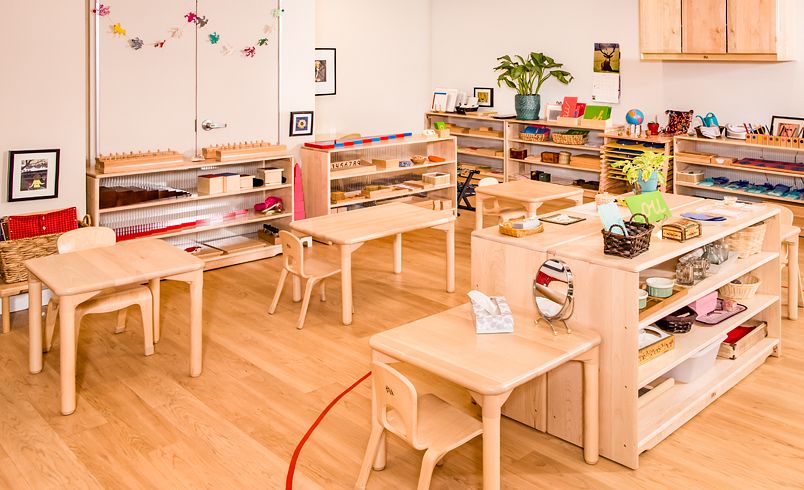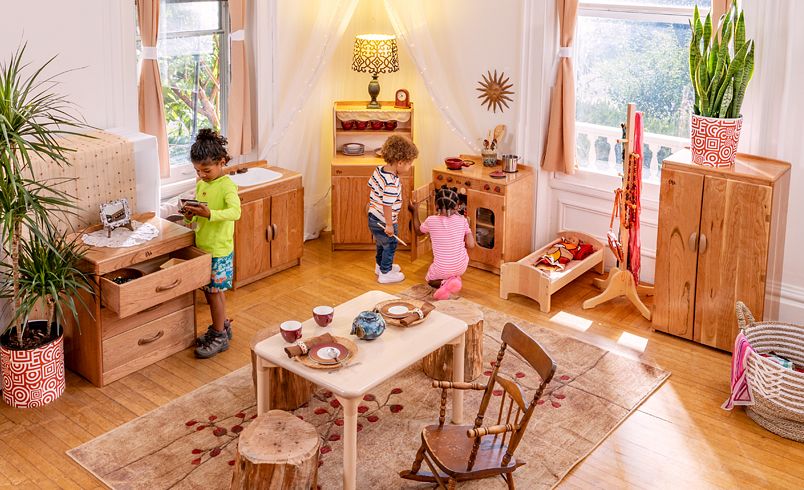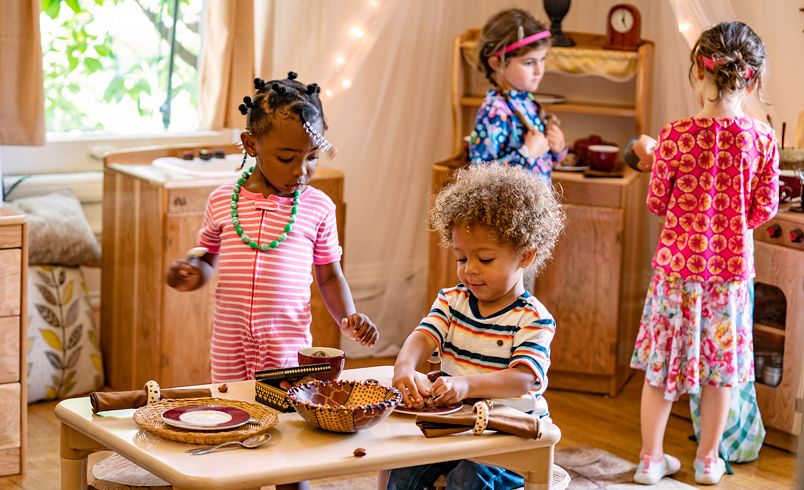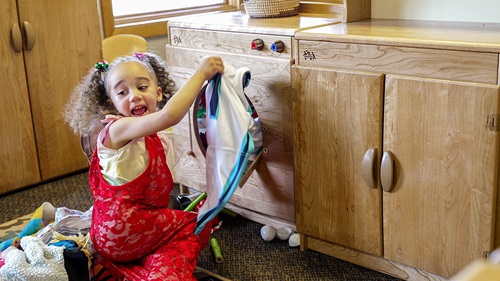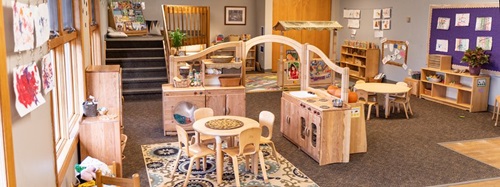It’s Time for a Change:
Creating Indoor Environments for Young Children
| September 2022My first school was a 400 plus-year-old farm house. The walls were made of wattle and daub (a lattice of wood strips covered with a mixture of clay, sand, mud, and straw), and whitewashed; the huge beams were made of a deep rich black oak darkened by the years. It’s believed they were originally part of an old ship. But, as much as I liked my school building, I could not wait to go outside and enjoy all the excitement and learning on the farm!
Environments for Young Children
Everyone who works with young children—and many who don’t—believe they know the ideal environment for the care and education of young children. My view is that this ideal environment is the outdoors, because:
- It is constantly changing. Children need novelty, change, and excitement: the daily movement of the sun’s position in the sky with lengthening shadows and changes in light; the seasonal changes that impact everything in the natural world; and the weather, which provides for all sorts of fun activities for children (deep snow for throwing and building, lots of rain for wading and damming, and the wind rushing through the trees for imagination).
- It provides all the colors of the rainbow. In the outdoors children are exposed to the entire palette of colors, from a brilliant blue sky and rich green fields, to subtle grey mist, a field of bright red poppies, and the deep, rich brown of recently turned soil. All the colors children will later experience in paint, crayons, books, and pens can first be experienced in expansive sunsets and the shades of autumn’s changing leaves.
- It is responsive to children. Children need environments that respond to them: a pond whose water ripples outwards after they throw in a stone; a pile of soft leaves that holds their tired body; stones that can be used to make a dam or build a house; and dead sticks to collect for a fire. Good environments respond to the child and allow children to have an impact on them.
- It sets a foundation for STEM. I believe the best foundation for STEM development in young children is the use of the outdoors: stacking stones, building forts, damming streams, collecting eggs, watching a chrysalis turn into a butterfly, observing a peregrine falcon dive for its food, and melting snow for water to drink (Committee for STEM education, 2018).
But, unfortunately, due to a wide variety of reasons, it’s often not practical to have children spend most of their time outdoors. The challenge for educators is to create an indoor classroom environment that contains as many of these elements as possible.
Classroom Design
In the beginning years of Head Start and other pioneering early childhood programs, child care centers simply had to adapt to available spaces. Many programs were in church basements; some in converted houses, and others in old school classrooms. The functionality of these spaces was often very challenging, both for the children and adults.
As classroom design evolved, different ideas influenced the process, including the need to impress adults—both parents and school administrators; implementing specific early childhood philosophies through the classroom design, and responding to new research on the impact of the environment on children’s behavior, attention, learning, and brain development.
Traditional Early Childhood Classrooms
We cannot discuss traditional approaches to classroom design, furniture, and equipment without discussing the influence of Montessori.
According to Montessori, “the objects surrounding the child should look solid and attractive to him, and the house of the child should be lovely and pleasant in all its particulars. . . . Its almost possible to say that there is a mathematical relationship between the beauty of his surroundings and the activity of the child: he will make discoveries rather more voluntarily in a gracious setting than in an ugly one” (Montessori, as quoted by Kahn, 1995, p. 9). Montessori materials and equipment are made of hardwood, carefully finished, and beautiful to look at and handle. Teachers create an orderly, well-maintained classroom; children return materials to their rightful places (Wardle, 2009).
Although the Montessori early childhood model was originally developed for children living in the slums of Rome, globally—with a few public school exceptions—Montessori has become synonymous with quality and social status.
Taking the lead from Montessori classrooms, a fairly standard approach to early childhood classroom design, furniture, and equipment has developed over the years. Walls are white or a light color; much of the equipment and materials are made of light-hue hardwoods (maple and birch in the U.S.; beech and birch in Europe); and furniture is used to carefully structure and order the classroom. This approach provides a sense of quality, order, and lightness—an important solution to classrooms which were often cramped, poorly designed, and poorly lit.
The thinking was to use the classroom walls, equipment, and materials to provide a neutral, attractive base against which children’s art work, curricula symbols, and instructional messages stand out, without the classroom becoming cluttered and over-stimulating (Greenman, 2005).
It’s Time for a Change
It is now time to change our view of the ideal indoor environment for young children. Today’s classrooms are better lit, larger, and often designed specifically for young children. The use of the outdoors has been greatly expanded, and “bringing the outdoors in” is a regular practice.
Further, we have a much better idea of how to rearrange the environment to provide continual novelty and challenge, without a classroom becoming cluttered and over-stimulating (Rike, Izumi-Taylor, & Moberly, 2008). Large windows and transition spaces between the outdoors and indoors can also open-up the indoor space (Wardle, 2018a). Finally, teachers and curricular experts continually change and adapt the classroom environment throughout the school year (Noble et al, 2021).
Reflecting Diversity
My favorite period in my English high school was Friday afternoon’s woodworking class. I greatly enjoyed designing and making furniture out of wood, and turning bowls on the lathe. One of the joys of working with wood is the different grains, smells, textures and colors of all the different hardwoods. Beech and birch are light-colored, with open grain; oak—especially quarter sawn—is a rich honey gold color with beautiful medullary rays; mahogany is a deep red/brown wood with a close, even grain; walnut a more open grain with dark, rich tones, and ebony is a deep-deep dark wood.
People, of course, also come in a beautiful rich diversity of skin and hair colors, tones, and hues. Recently the early childhood field—along with the rest of the educational community—has engaged in a critical re-examination of diversity. Throughout our history the field has been dominated by European traditions and a white, middle-class American perspective (Wardle, 2018b). We now recognize the need to expand our inclusiveness of diverse ideas, perspectives, aesthetics, and practices. Not only are children and families from diverse backgrounds embraced in our programs, but their cultures, races, nationalities, and languages are reflected in classroom decorations, children’s books, artifacts, artwork throughout the center, and curricular materials.
Classroom equipment and furniture should be made of diverse hardwoods that reflect the rich tones of the skin of all the children we serve; further, judicious use of color can be added—just as in the outside environment children enjoy a brilliant patch of yellow dandelions, a flash of blue from a passing blue jay’s wings, and the oranges, reds, and purples of a sunset.
Conclusion
Initially, preschool classrooms were designed and equipped to address a variety of challenges: poor lighting, inadequate space, clutter, and perceived over-stimulation. In addressing these challenges, many programs looked to the Montessori approach, because it was associated with quality and status. Thus many classrooms had light walls and were equipped with furniture and materials made of light, carefully finished hardwoods. Today, however, it is time to challenge this approach for a variety of reasons, including the need to reflect the rich skin tones of all the students we serve, and the fact classroom designs have changed dramatically over the years. We need to add wood of diverse hues and textures, and splashes of color in our preschool classrooms. However, even with these changes I predict that, given a choice, most young children will still elect to learn in the outdoor environment!
References
Committee for STEM Education (2018). Charting a course for success: America’s strategy for STEM education. Washington, DC: National Science and Technology Council.
Greenman, J. (2005). Caring spaces, learning places: Children’s environments that work (3rd ed.). Lincoln, NE: Exchange Press.
Kahn, D. (1995). What is a Montessori preschool? Cleveland, OH: North American Montessori Teachers’ Association.
Noble, H., Arango, M., Peterson, M., & Petz, S. M. (2021). Bringing Reggio inspired practice to a young public school. Exchange, 43 (6), 52-56.
Rike, C. J., Izumi-Taylor, S., & Moberly, D. (2008, May/June). We grow brains. Exchange, # 181, 22-26.
Wardle, F. (2009). Approaches to early childhood and elementary education. New York: Nova Science Publications, Inc.
Wardle, F. (2018a). Oh Boy! Strategies for teaching boys in early childhood. Lincoln, NE: Exchange Press.
Wardle, F. (2018b). Adding to our view of multicultural education. Childhood Education Innovations, 94 (5), 34-40.

